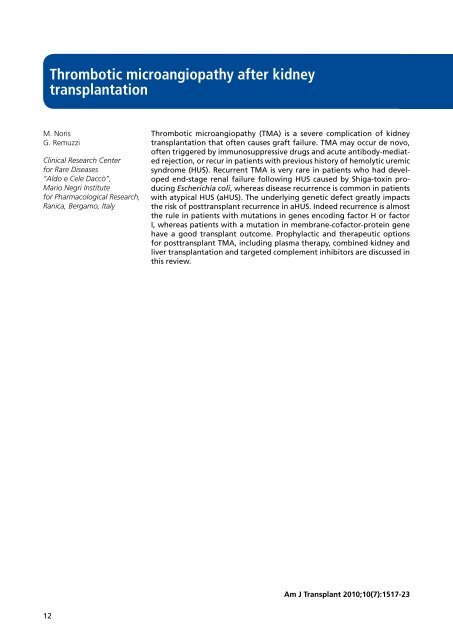AggiornAmenti in riAnimAzione e terApiA intensivA - Pacini Editore
AggiornAmenti in riAnimAzione e terApiA intensivA - Pacini Editore
AggiornAmenti in riAnimAzione e terApiA intensivA - Pacini Editore
You also want an ePaper? Increase the reach of your titles
YUMPU automatically turns print PDFs into web optimized ePapers that Google loves.
12<br />
thrombotic microangiopathy after kidney<br />
transplantation<br />
M. Noris<br />
G. Remuzzi<br />
Cl<strong>in</strong>ical Research Center<br />
for Rare Diseases<br />
“Aldo e Cele Daccò”,<br />
Mario Negri Institute<br />
for Pharmacological Research,<br />
Ranica, Bergamo, Italy<br />
Thrombotic microangiopathy (TMA) is a severe complication of kidney<br />
transplantation that often causes graft failure. TMA may occur de novo,<br />
often triggered by immunosuppressive drugs and acute antibody-mediated<br />
rejection, or recur <strong>in</strong> patients with previous history of hemolytic uremic<br />
syndrome (HUS). Recurrent TMA is very rare <strong>in</strong> patients who had developed<br />
end-stage renal failure follow<strong>in</strong>g HUS caused by Shiga-tox<strong>in</strong> produc<strong>in</strong>g<br />
Escherichia coli, whereas disease recurrence is common <strong>in</strong> patients<br />
with atypical HUS (aHUS). The underly<strong>in</strong>g genetic defect greatly impacts<br />
the risk of posttransplant recurrence <strong>in</strong> aHUS. Indeed recurrence is almost<br />
the rule <strong>in</strong> patients with mutations <strong>in</strong> genes encod<strong>in</strong>g factor H or factor<br />
I, whereas patients with a mutation <strong>in</strong> membrane-cofactor-prote<strong>in</strong> gene<br />
have a good transplant outcome. Prophylactic and therapeutic options<br />
for posttransplant TMA, <strong>in</strong>clud<strong>in</strong>g plasma therapy, comb<strong>in</strong>ed kidney and<br />
liver transplantation and targeted complement <strong>in</strong>hibitors are discussed <strong>in</strong><br />
this review.<br />
Am j Transplant 2010;10(7):1517-23







